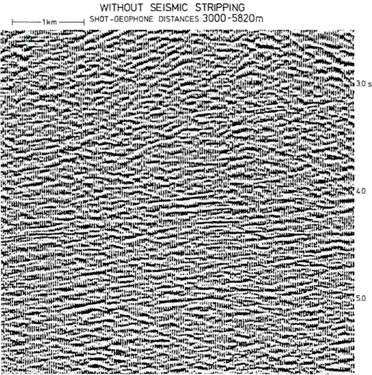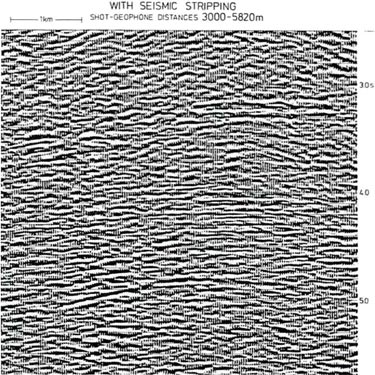Seismic Stripping
Th. Krey
Reflexionsseismische Untersuchungen auf Kohlenwasserstoffe in großen Tiefen erfordern in vielen Gebieten bei der Technik der Common-Reflection-Point-Stapelung sehr große Abstände zwischen Schußpunkt und Geophon. Wo Abstände von 1 bis 3 km keine erkennbaren Primärreflexionen brachten, sind Maximal-Schuß-Geophon-Abstände von 4 bis 6 km mit Erfolg angewandt worden.
Derart große Schuß-Geophon-Abstände setzen selbstverständlich eine zuverlässige Berechnung der statischen Korrekturen voraus, Korrekturen, die normalerweise die Effekte der Topographie und Verwitterungsschicht umfassen. In manchen Gegenden jedoch spielen auch die Geschwindigkeitsänderungen in den oberen Schichten bis etwa 2 km Tiefe eine Rolle; sie können längs Abständen, die viel kleiner sind als die maximalen Schuß-GeophonAbstände, beträchtlich sein, vor allem in Gebieten mit flachliegender Salztektonik (Halokinese). In solchen Fällen müssen die oberen Schichten in die Korrekturen, vor Anwendung des CRP-Stapelns, einbezogen werden. Die Wirkung solcher zusätzlichen Korrekturen, für die wir den Ausdruck "Seismic Stripping" (seismisches "Abdecken", "Abräumen") einführen möchten, ist in den Figuren 1 und 2 dargestellt.
In der Fig. 1 ist ein Teilstück einer seismischen Sektion abgebildet, in dem nur die normalen statischen Korrekturen angewandt wurden. Der Schuß-Geophon-Abstands-Bereich betrug 3 bis 5,82 km. Die CRP-überdeckung war 24fach. Andeutungen von Reflexionshorizonten gibt es bei etwa 3,0 s, 4,0 sund 5,0 s. In der gleichen Sektion, Fig. 2. sind Seismic-Stripping-Korrekturen zusätzlich angewandt worden. Sie wurden vom oberen Teil der Sektion (in den Figuren nicht gezeigt) abgeleitet, die im Zeitbereich 0 s bis 1,5 s engräumige strukturelle Merkmale halokinetischen Ursprungs aufweisen.
When extending the reflection seismic exploration for hydrocarbons to deep sedimentary layers it is necessary in many areas to use a large range of shot-geophone distances in the technique of common-reflection-point stacking. Maximum shot-geophon distances of 4 to 6 km have successfully been applied where distances of 1 to 3 km did not yield recognizable primary reflections. Of course, such large extensions of the shot a
Of course, such large extensions of the shot and geophone locations involved in one common reflection point presume a reliable computation of static corrections, which normally encompass the effects of topography and weathered layer. But, in some areas also the velocity alterations in the upper subsurface layers, say down to a depth of 2 km, can be very strong along distances much smaller than the maximum shot-geophone distances, especially when salt tectonics (halokinesis) with a rather shallow base of salt is encountered. In such cases, the subsurface layers have to be included in the corrections before applying CRP-stacking. The effectivity of such additional corrections, for which we should like to introduce the name of "Seismic Stripping", is presented in the figures 1 and 2.
Fig. 1 represents part of a seismic section with normal static corrections only. The shot-geophone-distance range was from 3 to 5.82 km. CRP coverage was 24-fold. Hints of reflecting horizons are indicated at about 3.0 s, 4.0 sand 5.0 s. In the section of fig. 2 additional seismic stripping corrections were applied.


Die Unterschiede in den Strippingkorrekturen für die verschiedenen Strahlenwege für einen CRP-Punkt erreichten Beträge bis zu 50 ms! Offensichtlich verursachten die Strippingkorrekturen eine beträchtliche Verbesserung der Reflexionsqualität bei den erwähnten Zeiten.
Strippingkorrekturen werden nun in verschiedenen Untersuchungsgebieten von PRAKLA-SEISMOS angewandt. Ein Vortrag ("Seismic Stripping Helps to Unravel Deep Reflections") von Th. Krey beim Annual International SEG Meeting 1975 in Denver gehalten, berichtet ausführlich unter Berücksichtigung der mathematischen Grundlagen über dieses Thema.
They were derived from the upper part of the section (0 to 1.5 s), which is not presented in the figures, and which is characterized by narrow structural features of halokinetic origin. The differences in the stripping corrections for the various raypaths of one CRP point exceeded 50 ms. Obviously the stripping corrections yielded a considerable improvement of reflection quality at the times mentioned.
Stripping corrections are now successfully being applied in various areas by PRAKLA-SEISMOS GMBH. The paper "Seismic Stripping Helps to Unravel Deep Reflections" presented by Th. Krey at the Denver Annual International SEG Meeting of 1975 will report in more detail on the topic of Seismic Stripping including the mathematical aspects.